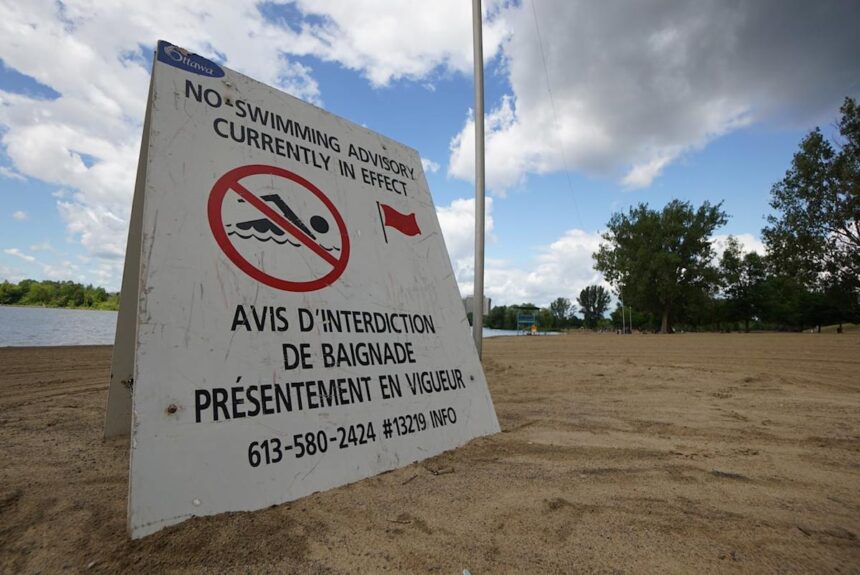The beach at Britannia Park was nearly empty when I arrived on a crisp June morning. A lone paddleboarder carved through the Ottawa River’s surface while two women walked barefoot along the shoreline, carefully avoiding debris washed up from spring floods. One of them, Marianne Thiessen, has been swimming here for over 20 years.
“We used to check the water quality reports religiously before bringing the kids,” she told me, gazing across the water. “Now we’re supposed to just… guess?”
Thiessen is one of many Ottawa residents concerned about recent changes to the city’s beach water testing program. Ottawa Public Health (OPH) confirmed last week it will no longer test water quality at five beaches: Britannia, Westboro, Petrie Island East Bay, Petrie River, and Mooney’s Bay.
The decision has sparked community backlash, particularly as summer approaches and families seek relief from increasingly intense heat waves. The cuts reduce monitoring from seven beaches to just two – Petrie Island East Bay and Mooney’s Bay.
Dr. Vera Etches, Ottawa’s Medical Officer of Health, defended the decision as aligning with provincial requirements. “The Ontario Public Health Standards only require us to monitor beaches with the highest use,” she explained during a phone interview. “We’re focusing our resources where they can have the greatest impact.”
According to OPH’s statement, water testing costs approximately $25,000 annually. The agency will continue water quality monitoring at just two beaches from June 15 to August 25, testing E. coli levels that indicate fecal contamination from stormwater runoff, wildlife, or sewage.
“We’re prioritizing public health resources while still meeting provincial obligations,” the statement read. “The testing schedule aligns with the Ontario Public Health Standards’ requirements.”
But environmental advocates argue this approach undermines public health protection. Mark Mattson, president of Swim Drink Fish Canada, argues provincial standards should be considered a minimum, not a target.
“These standards were developed decades ago and don’t reflect current recreational water use patterns,” Mattson explained. “Ottawa residents are increasingly turning to urban beaches during extreme heat events. Reducing monitoring during a climate crisis is moving in the wrong direction.”
Data from Environment and Climate Change Canada shows the Ottawa River watershed has experienced increasing precipitation intensity in recent years, raising contamination risks through combined sewer overflows. After heavy rainfall, untreated sewage and stormwater can overflow directly into waterways when treatment systems are overwhelmed.
The city has reported over 20 sewage overflow events in the past year, according to public works data obtained through freedom of information requests. These overflows typically occur after rainfall exceeding 20mm within 24 hours.
For Liz Miller, who coordinates the Ottawa River Defenders citizen science project, the timing couldn’t be worse. “We’re seeing record-breaking temperatures arrive earlier each year, while water quality monitoring is being reduced,” she said. “It creates a perfect storm of public health risk.”
Miller’s group has been training community volunteers to conduct their own water testing, but she emphasizes this shouldn’t replace official monitoring. “Citizen science complements government programs; it can’t replace them,” she told me while collecting water samples near Westboro Beach. “We don’t have the capacity or authority to issue public health advisories.”
The health implications extend beyond just recreational concerns. Dr. Anna Banerji, a pediatric infectious disease specialist at the University of Toronto, points to increasing waterborne illness risks as climate change intensifies.
“When children swim in contaminated water, they’re at risk for gastrointestinal illness, skin infections, and respiratory issues,” Dr. Banerji said. “Without regular monitoring, families can’t make informed decisions about water safety.”
The Canadian Medical Association Journal published research last year connecting climate change to increased waterborne disease outbreaks across Canada, particularly in regions experiencing more frequent severe precipitation events – a pattern increasingly evident in Eastern Ontario.
City Councillor Theresa Kavanagh, whose ward includes Britannia Beach, has requested OPH reconsider the decision. “My office has received hundreds of emails from concerned residents,” she said. “People expect their public health agency to be expanding environmental monitoring during a climate crisis, not cutting it.”
Kavanagh has initiated discussions with the Ottawa Riverkeeper organization to explore potential partnership models that could restore testing. “Other municipalities have developed creative solutions, including sponsorship programs and volunteer monitoring networks that meet public health standards,” she added.
Walking along Britannia’s shoreline, I noticed the beach’s popularity even on a weekday morning. Families with young children were beginning to arrive, setting up umbrellas and picnic blankets despite the “No Lifeguard on Duty” signs.
Marianne Thiessen pointed toward the water where her grandchildren once played. “The river has always had good days and bad days,” she reflected. “But at least we used to know which was which.”
As Ottawa faces another summer of climate extremes, the decision to reduce beach water testing highlights growing tensions between resource constraints and public health priorities. For residents like Thiessen, it represents more than just recreational convenience – it’s about maintaining connection to the waterways that define the city’s geography and cultural identity.
“We’ll probably still come,” she admitted, watching the paddleboarder glide toward the shore. “But we’ll always be wondering what we’re swimming in.”






